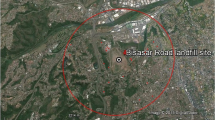Abstract
It is more and more recognised that an estimation of the exposure of the population to air pollutants is more relevant than the ambient air quality, since it gives a better indication of health risk. Outdoor workers in an urban region are generally of low income status and are exposed to higher levels of both indoor and outdoor air pollution. Hence respondents from this population subgroup have been selected for this study. Outdoor workers are divided into two categories, viz. traffic constables and casual outdoor workers like watchmen, roadside shopkeepers etc. Most of the respondents are from the lower income group. Each respondent is monitored for a continuous 48-hour period. The sampling frequency is once a week.
The study region is situated in the north-west part of the Greater Mumbai Municipal Corporation. It can be classified as industrial cum residential area. The daily integrated exposure of the outdoor workers consists of two major micro-environments, viz. occupational and indoor residential.
A personal air sampler was used along with a cyclone to measure levels of Respirable Particulate Matter (RPM). The cyclone has a 50% removal efficiency for particle diameter of 5 μm. Paired samples of PM10 (ambient) and RPM (personal) were collected to establish the correlation between them. The average 24-hour integrated exposure to RPM was 322 μg/m3 and exceeded the corresponding PM10 level observed at the nearest Ambient Air Quality Monitoring Station by a factor of 2.25. The 90% confidence interval for this exposure is 283–368 μg/m3. This study clearly demonstrates that the daily integrated exposure and therefore the health risk of outdoor workers in an urban area is significantly more serious than that indicated by ambient air quality data.
Similar content being viewed by others
References
Binder, R. E. Mitchell, C. A., Hosein, H. R. and Bouhuys, A.: 1976, ‘Importance of the indoor environment in air pollution exposure', Ach. Environ. Health 31, 277–279.
Brook, J. R., Dann, T. F. and Burnett, R. T.: 1997, ‘The relationship among TSP, PM10, PM2.5, and inorganic constituents of atmospheric particulate matter at multiple Canadian locations', J. Air and Waste Manage. Assoc. 47, 2–19.
Duan, N.: 1980: ‘Microenvironment Types: a Model for Human Exposure to Air Pollution', (SIMS technical Report), Stanford, USA, Department of Statistics, Stanford University.
Larssen, S., Gram, F., Hagen, L. O., Jansen, H. and Olsthoorn, X.: 1994, URBAIR Bombay City Specific report.
MEF.: 1994, ‘National Ambient Air Quality Standards', Ministry of Environment and Forests, Government of India notification, April 1994.
Smith, K. R., Aggarwal, A. L. and Dave, R, M.: 1984, Status of India's Environment - 1984–85, p. 124.
Spengler, J. D., Dockery, D. W., Reed, M. P., Tosteson, T. and Quinlan, P.: 1980, ‘Personal exposure to respirable particulate', Presented at: 73rd annual of the Air Pollution Control Association; June; Canada. J. Air Pollution Control Association; paper no. 80–61.5b.
Wallace, L.: 1996, ‘Indoor particles: a review', J. Air and Waste Manag. Assoc. 46, 98–126.
Rights and permissions
About this article
Cite this article
Kulkarni, M.M., Patil, R.S. Monitoring of Daily Integrated Exposure of Outdoor Workers to Respirable Particulate Matter in an Urban Region of India. Environ Monit Assess 56, 129–146 (1999). https://doi.org/10.1023/A:1005947301971
Issue Date:
DOI: https://doi.org/10.1023/A:1005947301971




